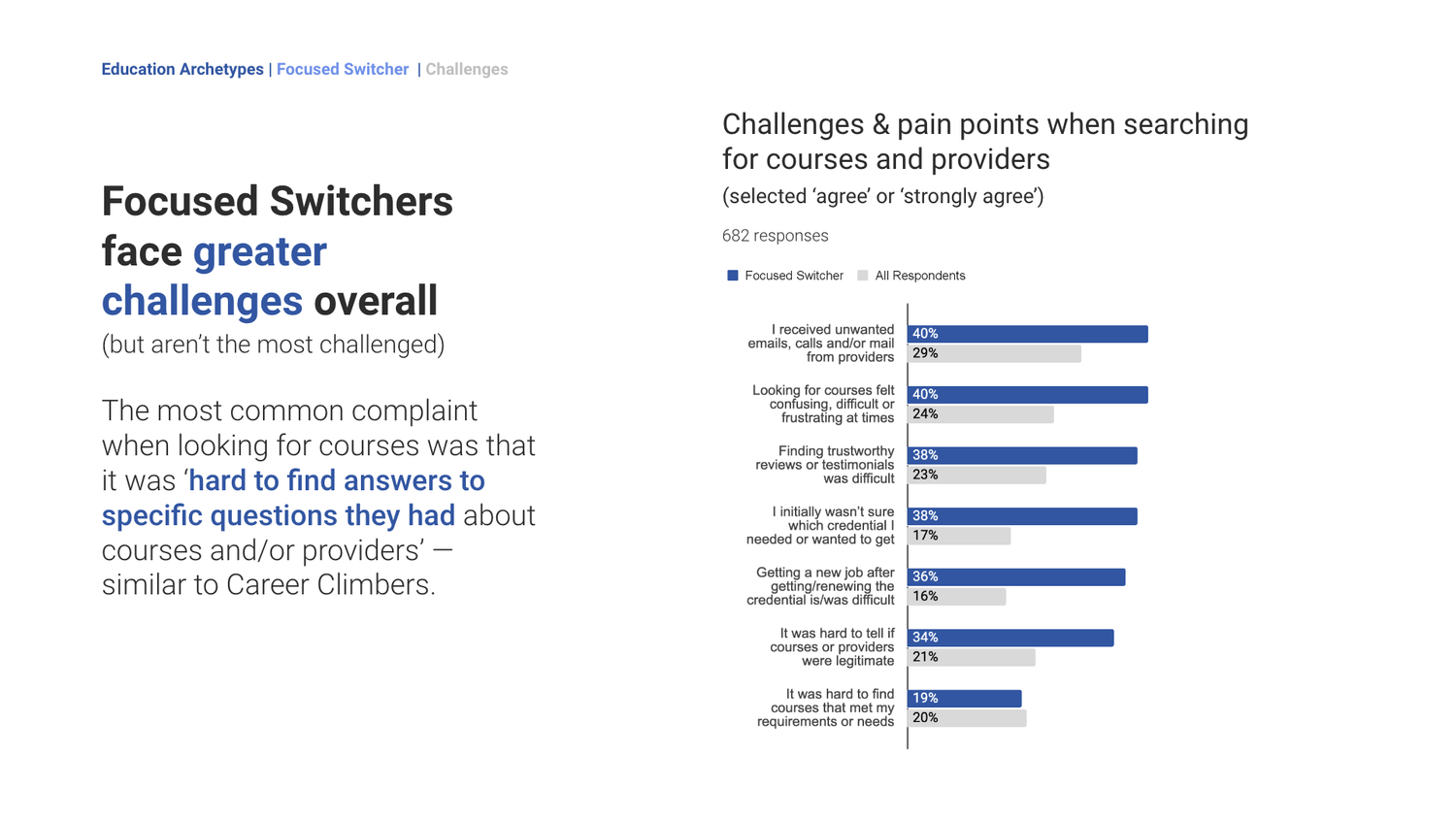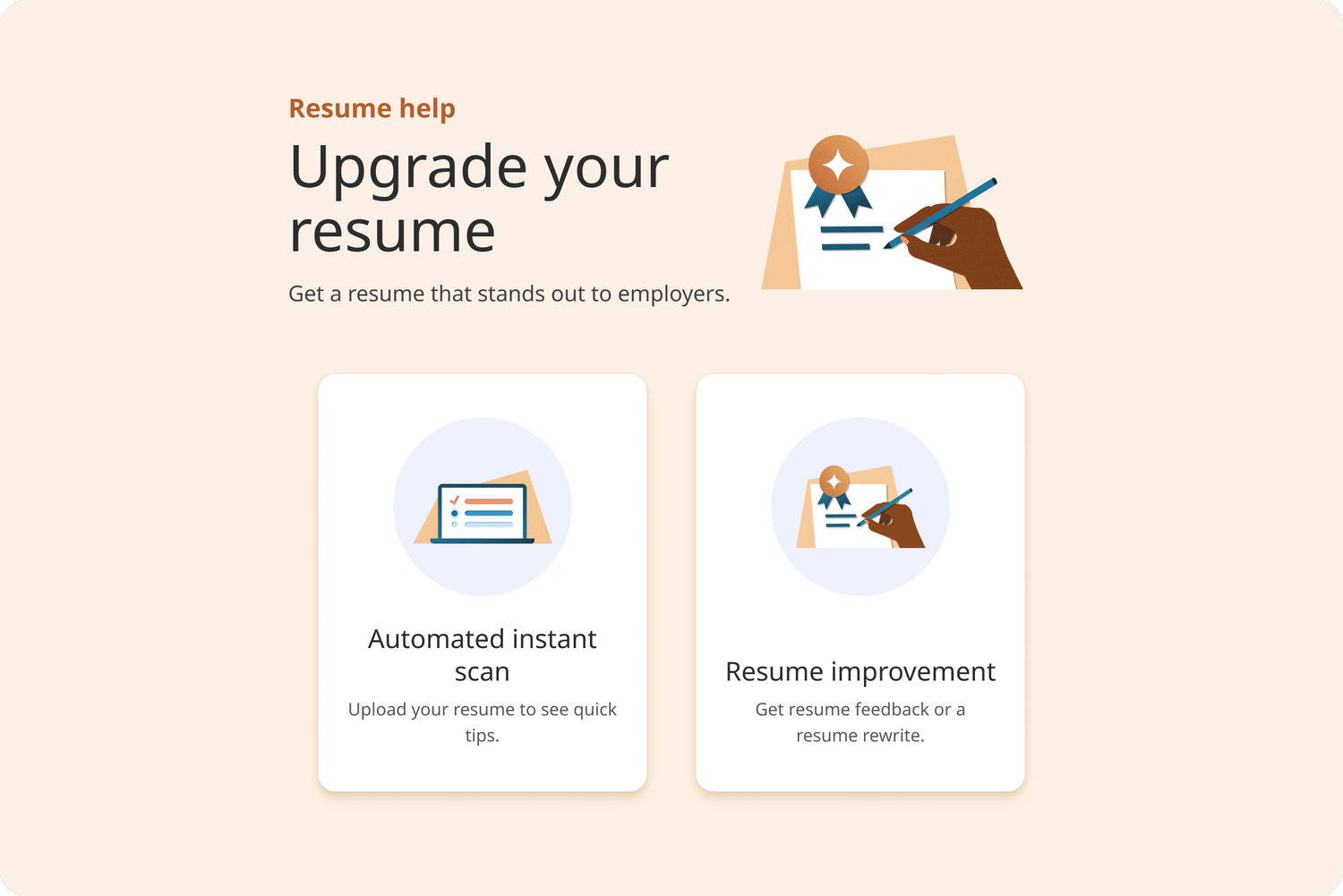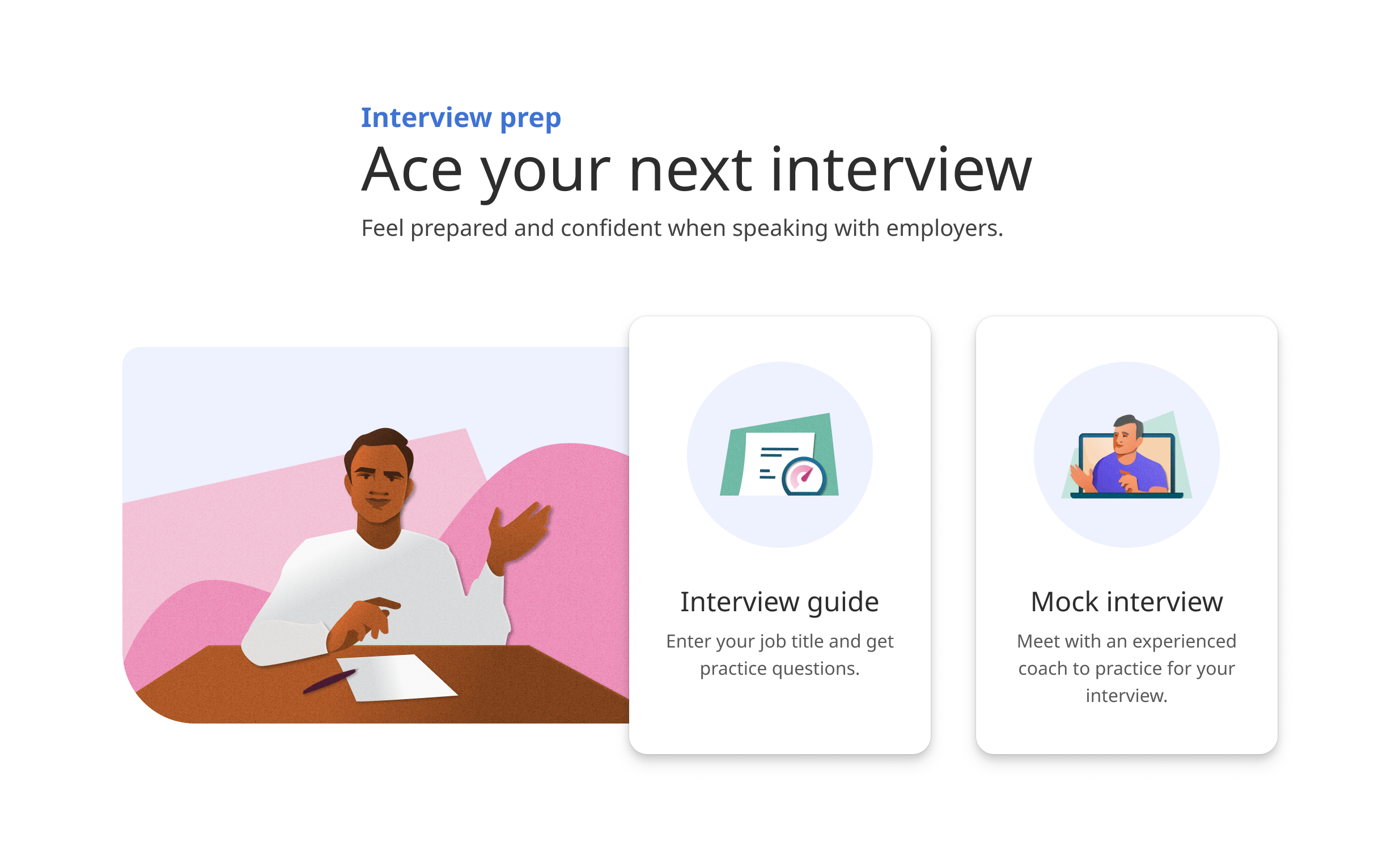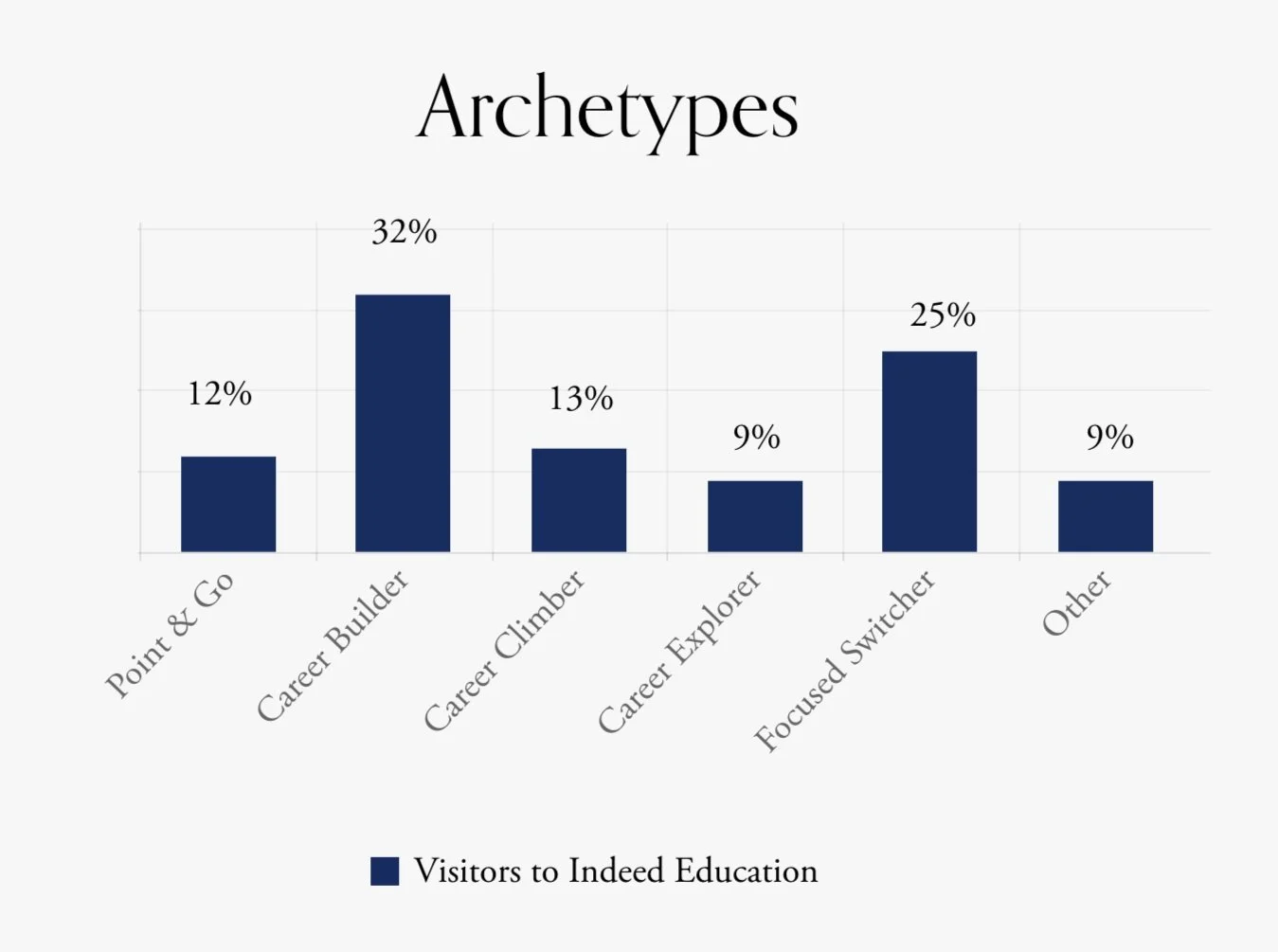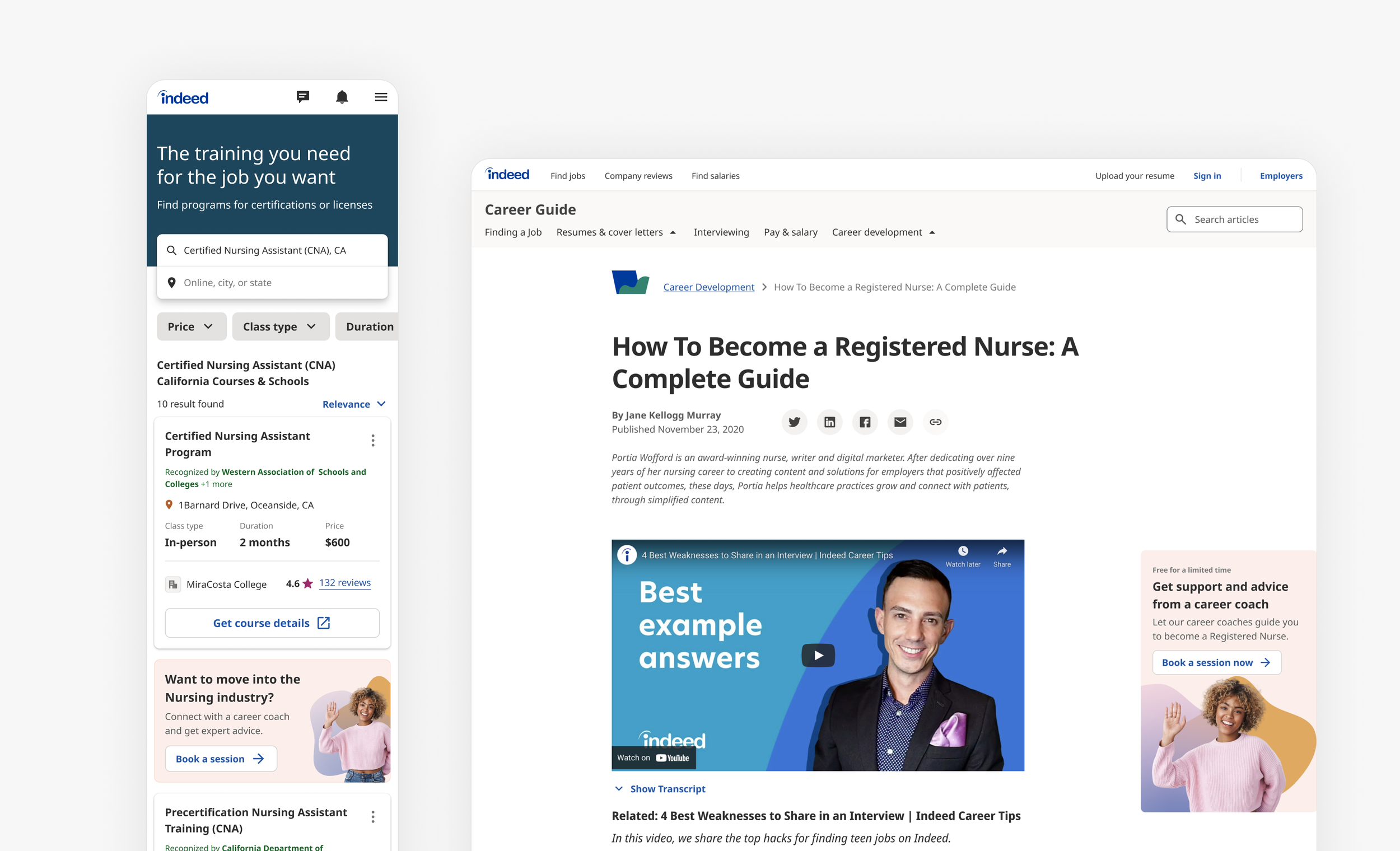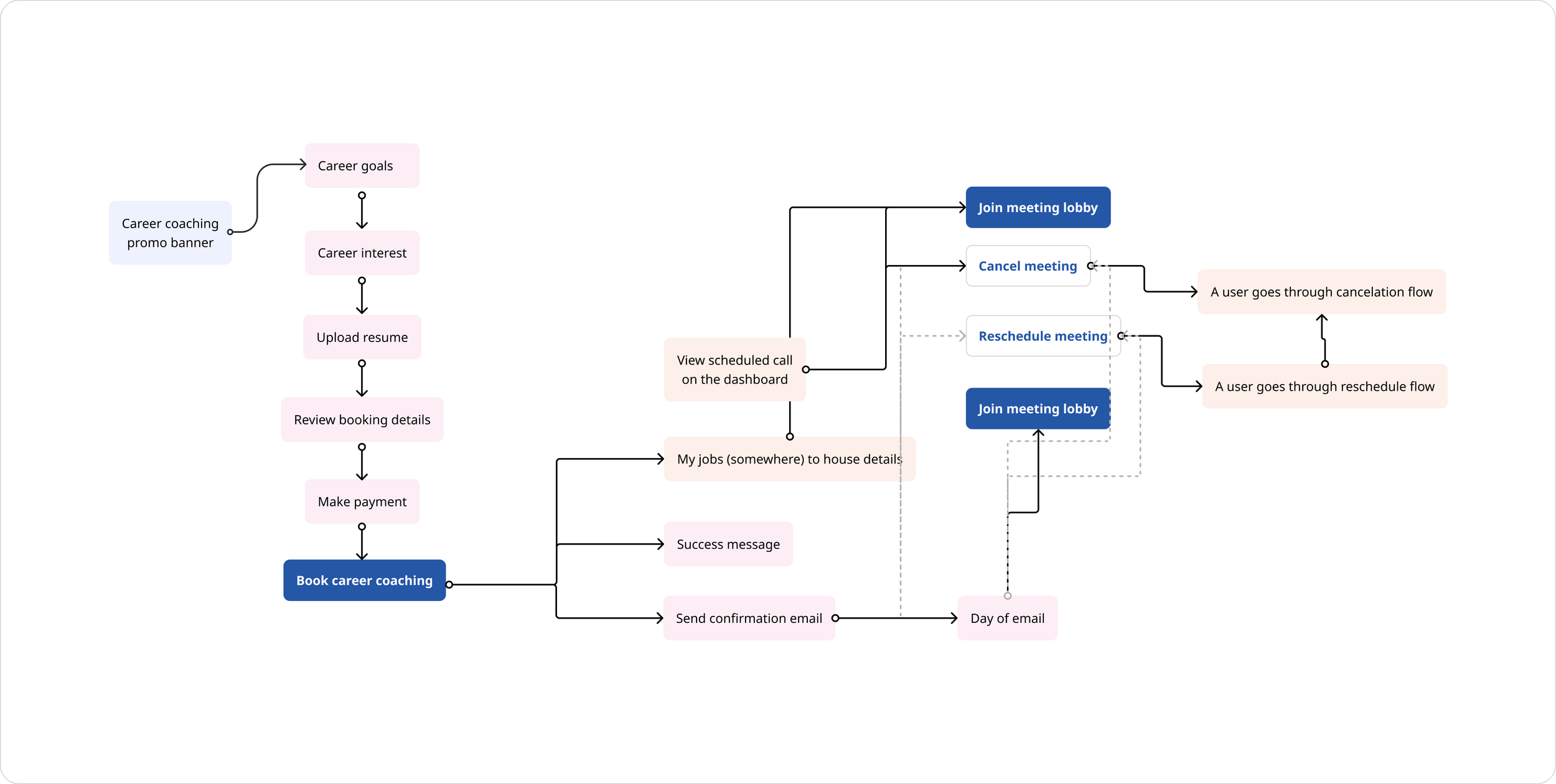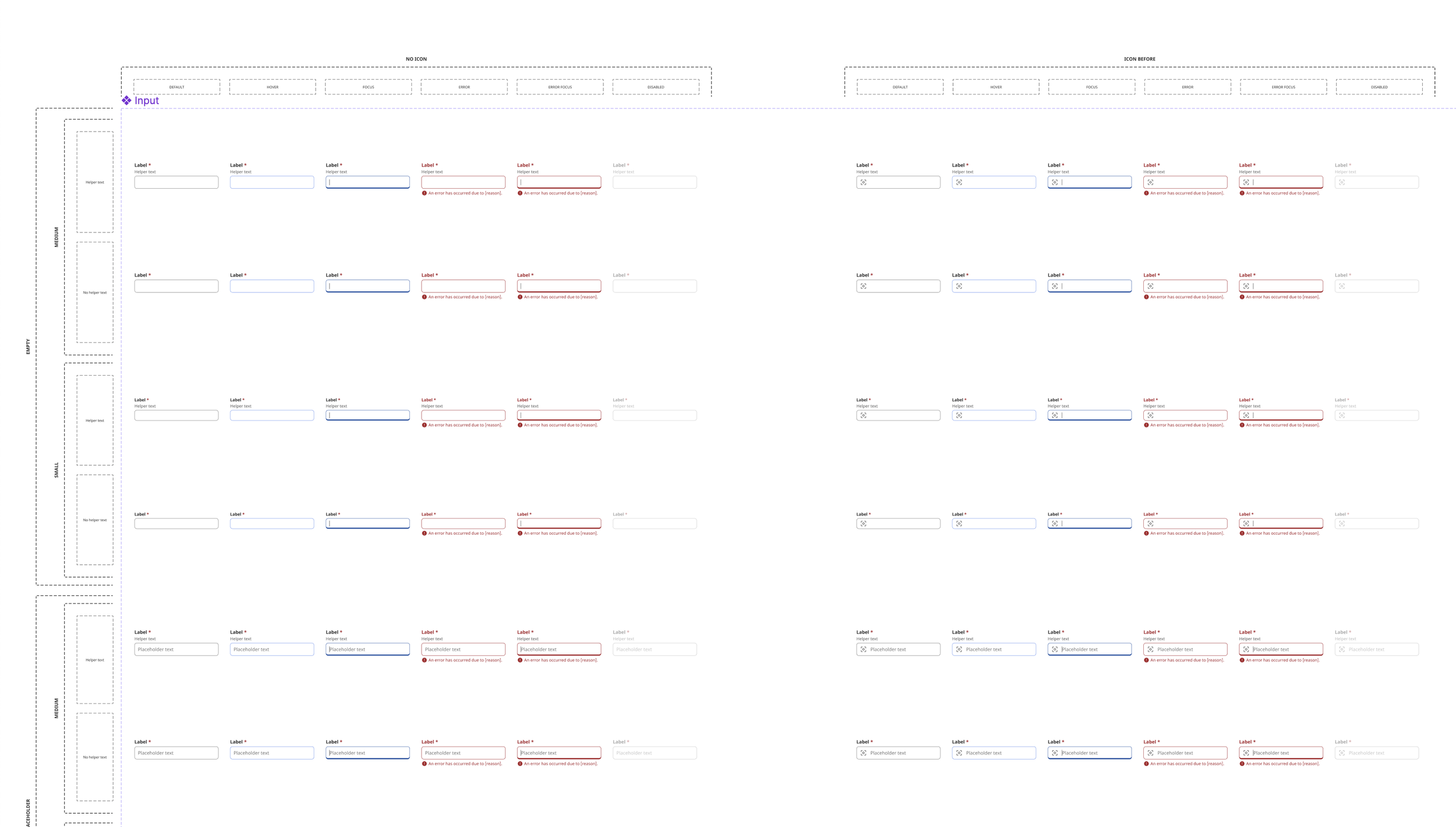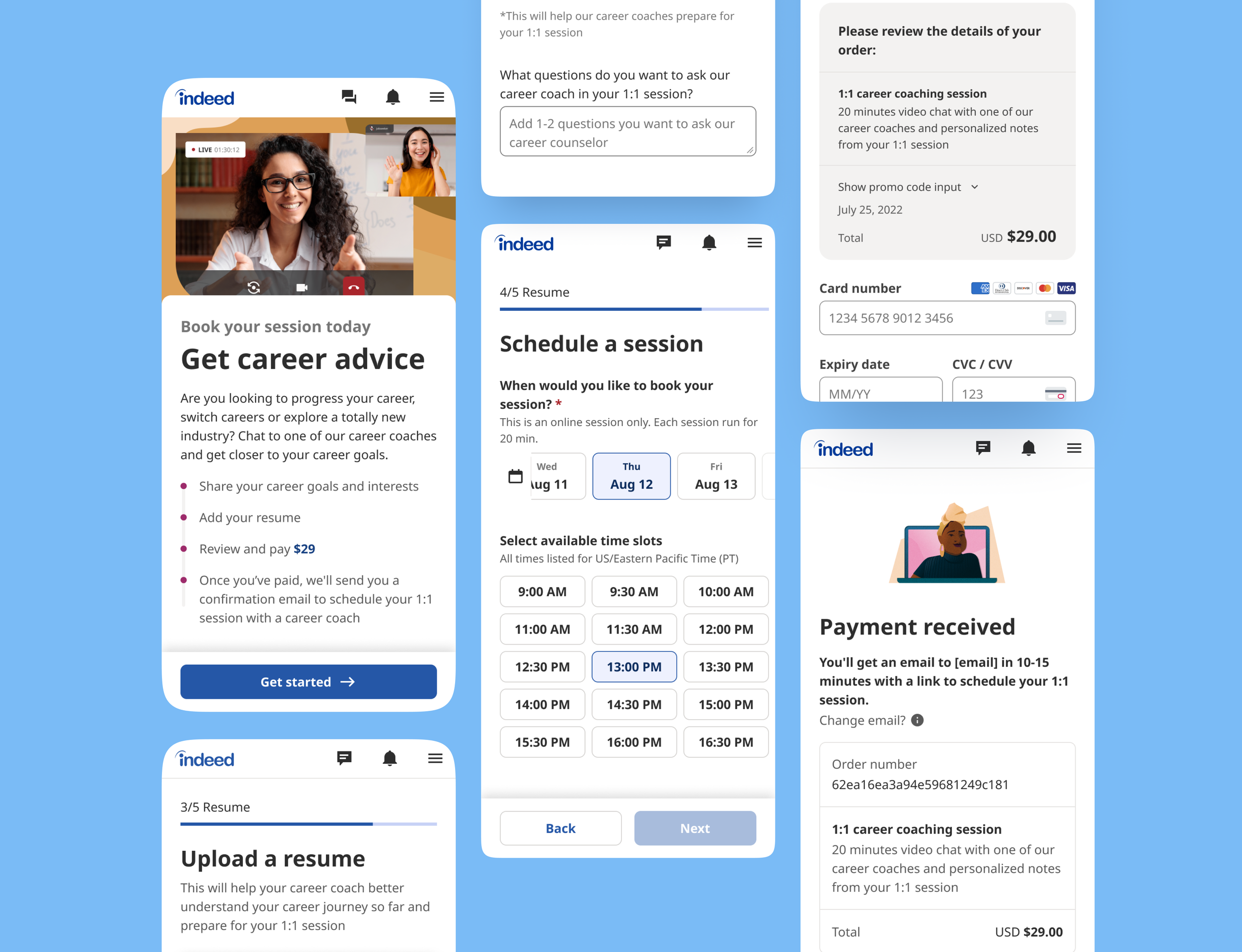Career Coaching —
The Expert Guidance For Your Career
Project
1:1 Career Coaching ServiceMy contribution
As the UX Lead for Indeed Education (Discovery Team), I led the work on UX strategy, UXUI design, prototyping, and data analysis to measure the service’s impact and identified areas for improvement. Skills/ Expertise
User Research, UX Strategy, Design Thinking, User Experience Design, Prototyping, Data AnalysisTimeline/ Duration
Jul to Sep 2022
Tool
UserTesting, Miro, FigmaOverview
Indeed connects millions with job opportunities, yet there's a gap in providing the human connection and support crucial for those seeking not just jobs but also career guidance and development. Both job seekers and current workers need access to coaches, industry experts, and a supportive community to navigate their unique career paths and tackle individual challenges.Background
The Education North Star vision aims to provide a comprehensive end-to-end support for workers, including personalised career recommendations, expert guidance, education resources, and job matching services, all consolidated into a single, accessible platform.
While the North Star vision established a strategic framework, subsequent projects were developed to address distinct aspects of Education and worker needs. Each initiative, aligned with the overarching vision, was tailored to deliver targeted value.
This project zeroes in on the. Career Coaching service, a fundamental element of the North Star vision's expert guidance facet. The initiative's core objective is to offer holistic support to individuals navigating career transitions. It achieves this by facilitating connections with experienced coaches, industry professionals, and a supportive peer community. Our ultimate goal is to empower workers, equipping them with the confidence and competencies necessary to thrive in their career paths.Research Discovery
Deep-diving into user problems
Before we dive in, it's essential to thoroughly grasp the expectations and challenges that workers encounter, with a particular emphasis on the Career-Switching archetypes highlighted in our Education North Star vision. This foundational understanding is critical for ensuring that our strategies and solutions are effectively aligned with the actual needs and realities of our target audience.User problems identified from qual and quant data (survey & interview) for Career-Switching archetype
What More Have We Learned?
Our research revealed a clear preference among individuals for recommendations originating from trusted and closely connected professional contacts
Our research underscores the significant role of professional networks in career guidance, aligning perfectly with our goal to embed expert, specialised, and personalised advice into the essence of Education and job-seeking processes. The preference for human interaction, especially in critical decisions like career changes, was a recurring theme in our user interviews and surveys.
Leveraging these insights, we're dedicated to enriching our support during these pivotal moments by establishing a robust network of coaches, mentors, and industry experts. This initiative aims to bridge the gap between workers and valuable resources, facilitating informed and impactful career transitions.Shaping Our Product Strategy
Leveraging the power of professional networks, we aim to connect workers with suitable coaches and mentors, providing support that's both effective and customised. This strategy is crafted to empower individuals by boosting their confidence and facilitating the achievement of their career goals.
Product Objective
Our goal is to create a Career Coaching service that offers workers personalised access to expert guidance through 1:1 video sessions
This approach ensures that every participant receives the precise support, insights, and encouragement they require to navigate their career path effectively, making the platform a reliable partner throughout their career journey.Comparative Research
Understanding the user journey of individuals who use similar support services
At present, Indeed Career Services provides in-person support to job seekers, focusing on enhancing their resume writing, interviewing, and pay negotiation skills, with a mix of free and paid offerings.
However, our research has identified a notable discrepancy: while we address immediate job-seeking skills, there's a broader, unmet demand for comprehensive career guidance and development.
💡 This identified gap unveils a significant opportunity. It allows us to enhance our value proposition to job seekers and workers in this segment by providing a more thorough and personalised form of support. By extending beyond the traditional scope of job-seeking, we can delve into the realm of holistic career advancement.We believe that the optimal approach to providing our users with a comprehensive suite of career development tools and services lies in refining the user experience and augmenting the existing offerings of Indeed Career Services. By focusing on a more seamless and enriched interface, we aim to empower our users with the resources they need for well-rounded career progression.
Adopting this strategy will enable us to swiftly evaluate the product-market fit and secure early wins for our team, laying a strong foundation for the continued growth and success of our career development initiatives.Getting Started
Learning from users is continuous process, sharpening our understanding and guiding the development of our services
To ensure our product truly aligns with user needs, it's crucial to continuously seek feedback and derive insights to effectively assess product-market fit. Key aspects to explore include user perception of the value offered by 1:1 coaching sessions, their willingness to invest in these services, the level of active participation in sessions, and their feedback regarding the overall experience and the quality of advice received.
Questions we need to consider include:Do users need more than just written content?Are they prepared to pay for these services?What precise kind of guidance do they anticipate receiving during the sessions?
Survey targeting users landing on the Education Marketplace
What Have We Learned
A significant segment of users on Indeed Education falls into the Career-Switching archetype. This observation presents a valuable opportunity to delve deeper by examining the experiences of users who have engaged with:
47.1%
job seekers were open to changing careers, 25.4%
were actively looking for a career switch Indeed JS Archetype survey 2022
01
✦ The Education Marketplace, a crucial platform for understanding users' career motivations and measuring their interest in personalised 1:1 coaching sessions. The fact that users frequent the Marketplace to seek professional certifications and licenses underscores their commitment to upskilling or reskilling. This platform serves as a rich source of data, providing valuable insights into the professional growth aspirations of our users and potentially guiding the enhancement of our Career Coaching services to better meet their evolving needs.02
✦ Targeting users via Career Guide* articles, which attract the highest organic traffic on Indeed, can provide crucial insights into the role of content in user engagement and the possible interest in 1:1 coaching for guidance during the exploration phase. Specifically, users who navigate to "How to become a XYZ" articles are often seeking detailed information about a particular career path. This group likely includes individuals contemplating a career switch, making them a prime audience for understanding the demand for and impact of in-depth, personalised career coaching services.*Career Guide offers various resources to support job seekers, such as articles, resume samples, and videos, to help them feel confident in their job search and career.
01
02
By analysing the behaviour and feedback of these users, we can uncover nuanced insights, tailor our offerings more effectively, and address the unique challenges and aspirations of Career Switchers.How Might We Build a Coherent User Experience
Leveraging the foundational elements of Career Services, our approach is to enhance, not reinvent, the existing user experience
Prior to diving into the design phase, I prioritised a thorough comprehension of the current tools and services offered by Career Services. This understanding is key to maintaining consistency and effectiveness throughout the user journey.
The first step involved a detailed audit of the Career Services resume coaching funnel. The purpose of this audit was twofold: firstly, to pinpoint areas ripe for enhancement, and secondly, to extract insights from the questions posed during the sign-up process. The overarching aim was to ensure that my design proposals not only resonate with user requirements but also harmonise with the prevailing vision and goals of Career Services' products and services.By refining existing components and leveraging them to construct forms tailored to gather insights into user motivations, we can facilitate personalised career coach matching. This strategy aims to offer an efficient and seamless experience, aligning with the quality and user-friendliness characteristic of other support services provided by Career Services.
Embracing this approach ensures a consistent user experience and guarantees that our design is in perfect harmony with the existing vision and objectives of the initiative, maintaining a cohesive and strategic direction.User Flow
Streamlining the career coaching journey
The primary aim was to establish straightforward and accessible pathways within the Career Coaching service, involving the creation of intuitive flows that span the entire user journey. This includes the initiation of bookings, payment processing, session scheduling, and forming connections with career coaches. The objective was to guarantee a smooth and user-friendly experience, meticulously aligned with the overarching structure of Career Services while promoting robust collaboration with the cross-functional product team.Adopting a Content-First Strategy
Prioritising structure and user needs in coaching session bookings
Beginning with a content-first design approach allows me to focus on the organisation and prioritisation of content blocks and structure before addressing the website's visual elements. This approach helps in gaining a deep understanding of user needs related to booking coaching sessions and in offering substantial support for these requirements. It also guarantees that the content is well-organised, straightforward, and user-friendly, enhancing the overall user journey.-
Navigate users end-to-end through their extensive journey, providing unwavering guidance and motivation to ensure they remain focused and inspired.
-
Enrich the experience with genuine support from coaches, mentors, and a vibrant community, fostering a network of human connections that empower and uplift.
-
Offer intelligently tailored recommendations and configurable steps, ensuring each user's journey is highly personalised and directly aligned with their individual aspirations and goals.
-
Keep interfaces simple and intuitive, allowing users to navigate with clarity and ease.
-
Create a cohesive experience across the platform, where every element reflects a unified brand voice and vision.
Ensuring that the product design principles are consistently applied during the content structuring and modeling phase is important. These principles, outlined to the left and formulated based on insights and expectations from key product stakeholders, are fundamental in fostering a unified and coherent approach to our product development strategy.
By diligently incorporating these principles throughout each phase of my design process, I am assured that my design choices and decisions will continuously resonate with and reinforce our fundamental design ethos. From Framework to Interaction
Crafting a cohesive user experience with content-driven visual design
After solidifying the content framework, my attention pivots to crafting the visual and interactive components. The content blocks from my early design process serve as a guide for determining what visual elements to include, how to present the information visually, and the ways users will engage with the content. This ensures a cohesive and intuitive user experience, seamlessly integrating the content with its visual and interactive counterparts.To maintain a unified user experience and ensure consistency across our design system, I emphasise the reuse of form inputs and elements for the coaching funnel, drawing from Career Services’ current suite of career development services. I aim to drive cohesive patterns across all platforms and touch points, ensuring that our users have a seamless and consistent experience regardless of where they engage with our services.
Feedback and Iterations
Design iterations
To meet stakeholder expectations, I set up an extensive feedback system with the Career Services product lead and the team. Drawing on initial inputs of the team, I continuously refined and evolved the career coaching designs. This iterative process resulted in several versions of the final concept, each iteration focused on improving the user experience and aligning closely with the overarching career coaching goals.Test, Learn, Iterate
Engineering handoff
The Engineering handoff process is a crucial step in ensuring that the design is effectively translated into a functional product. To facilitate this, I redlined the necessary screens, providing detailed annotations and design specifications for each screen in Figma. This approach ensures that the Engineering team has clear guidance on the required changes and modifications, ultimately leading to a smoother and more efficient development process. It's great to hear that the Engineering team appreciated the extra effort put into this step.Subsequently, I developed a high-fidelity prototype, which I presented to the Career Services cross-functional team to secure their buy-in and ensure alignment. This prototype also acts as a practical guide for the Engineering team, providing an interactive representation of the intended user flow and interactions.For an optimised viewing experience, you can press 'F' on your keyboard or click the maximise icon at the top right of the frame below to enter full-screen mode. Should you need to reset the user flow at any stage, simply press 'R'. I encourage you to explore and interact with the prototype as detailed below (see ↓).Product Evaluation
We launched the 1:1 Career Coaching service in collaboration with Career Services in September 2022 🎉
In September 2022, we introduced the Career Coaching service, a collaborative effort with Indeed Career Services, aimed at rapidly determining its market fit and securing early successes for the Indeed Education team.
However, by October, the service had not attracted any sign-ups. To understand the reasons behind this lack of initial adoption, I embarked on a thorough review process. This involved analysing relevant data, gathering feedback directly from users, and carrying out user testing sessions to scrutinise every aspect of the service.Data Analysis
Examining reasons for Career Coaching service low sign-up rate through the lens of qual and quant data
Career Coaching engagement across funnel:
Resume Consultation engagement across funnel:
The Career Coaching service isn't matching up to the performance of the Resume Consultation service offered by Career Services. To address this, I embarked on a comprehensive analysis, examining user behaviour, conversion rates, and bounce rates at each stage of the funnel. My goal was to pinpoint potential problems and areas where the Career Coaching service could be enhanced.Based on the user feedback and engagement data I've analysed, I've developed a hypothesis around several factors that might be contributing to the lower performance of the Career Coaching service compared to the Resume Consultation service:Unclear value proposition: It's possible that users aren't fully grasping the benefits of the Career Coaching service, affecting their decision to sign up.
Limited visibility: The Career Coaching banner isn't as prominent as the Resume Consultation's, especially since it's not featured on multiple landing pages, resulting in fewer users navigating to the service's orientation page.
Mandatory questions: The requirement for users to answer questions about their career goals and interests before booking the service might be off-putting for some.
Irrelevant steps: The step of uploading a resume may seem unnecessary for users who are looking for career coaching rather than resume assistance.
Price sensitivity: The cost of the coaching service, priced at $29USD, might be seen as too steep, deterring potential sign-ups.
While tackling these factors could potentially enhance our Career Coaching service and boost sign-ups, it's important to remember that these are, at this stage, informed hypotheses.
Consequently, validating these hypotheses through user insights is essential. By engaging with our users and gathering their perspectives, we can obtain more precise and practical information, enabling us to refine the product effectively, and ensuring it aligns with the actual needs and expectations of our users.Validating Current Solution
Initiating user testing to investigate the drop-off points in the Career Coaching sign-up flow
I collaborated with a Rapid Researcher to plan and execute unmoderated usability testing sessions, focusing on a mobile prototype of the Career Coach sign-up flow. This collaboration was aimed at gaining a deeper understanding of the user experience, identifying any pain points or obstacles within the sign-up process, and ensuring that the flow is intuitive and user-friendly. The insights gathered from these sessions will be instrumental in refining the sign-up flow, enhancing user satisfaction, and ultimately increasing the adoption of the Career Coaching service.The goal of the study was to:
Evaluate the usability and comprehension of the user experience
Gain an understanding of Career Switchers’ thoughts on the purpose and benefits of the service
Identify potential "abandon" points of the career coach sign-up flow
Who we recruited
A total of 6 participants, who intend to switch to Certified Nursing Assistant and Software Engineering careers. Half of the participants entered the flow from the Edu SERP page, while the other half entered from a Career Guide article.
Intend to switch
- Actively or passively exploring to switch into a CNA / SWE job
- Currently in a different job and/or industry
Research Findings
🎮
Unpacking key insights from user testing
After conducting 6 user testing sessions, I analysed the data to extract key insights. This deep dive into the user feedback and interaction patterns revealed the underlying reasons for the low number of paid sign-ups. With these insights, I synthesised the research findings and pinpointed specific areas for improvement (see below ↓)01
Value proposition content for our users
Making sure our users know what to expect from the session is key to setting clear expectations and boosting engagement.
✦ Proposed Solutions/Action items:
1. Outline session offerings: Explicitly communicate the benefits and specific services our users will receive during the session. This could include career advice, resume feedback, or interview preparation.
2. Highlight coach expertise: Feature the career coaches prominently, showcasing their photos alongside detailed profiles highlighting their qualifications, areas of expertise, and unique skills. This adds a personal element, fostering trust and giving our users confidence in the quality of the service.
02
Funnel optimisation
Some participants found the process of entering questions for a coach to be time-consuming, and they expected to schedule a date before making a payment. These issues could potentially lead to drop-offs in the sign-up flow.
✦ Proposed Solutions/Action items:
1. Streamline the questionnaire: Reconsider if the initial questionnaire is needed. Make it shorter or optional, or switch to multiple-choice to save time.
2. Focus on relevant steps: If uploading a resume isn't needed for career coaching , remove that step. Keep only essential steps to maintain user focus and progress.
3. Schedule first, then pay: Let our users schedule their session before asking for payment. This order meets user expectations and makes the process smoother, possibly reducing drop-offs.
03
Cost of service
Choosing to offer a free or paid service can greatly affect the number of users signing up and how satisfied they are.
✦ Proposed Solutions/Action items:
Explore Free vs. Paid service options:
- Think about starting with free introductory sessions and then moving to a paid model. This lets our users try the service without spending money upfront.
- Understand how sensitive our users are to price to set the right cost.
- Use market research or A/B testing to strike the right balance, making the service affordable for users while also ensuring it's profitable.
04
Length of service
Matching the length of the coaching session with what our users expect is key to their satisfaction and the session's success.
✦ Proposed Solutions/Action items:
Conduct focused research: Find out if users prefer an hour-long session. This can be done through surveys or feedback forms.
Final Design
Putting it all on screens
After integrating feedback from user testing, several updates were implemented to enhance the user experience:Introducing a scheduling flow: A new step was added, allowing users to schedule their sessions before proceeding to payment, aligning with user expectations for a smoother process.
Simplifying the questionnaire: The mandatory questionnaire for career coaches was removed or made optional, streamlining the sign-up process and reducing the time and effort required from users.
Refining value proposition and messaging: The messaging around the Career Coaching service was enhanced to more clearly communicate its benefits and value, ensuring our users have a clear understanding of what the service offers and how it can meet their needs.
Impact
12% increase in conversion rates, which is a significant improvement.
This uptick has led to the booking of 170 career coaching sessions, culminating in earnings of $4,930 USD in just 1 month.
Improved average user feedback rating for the service from 4.5 to 4.85 after adding/ implementing the scheduling flow within the sign-up funnel.User provides feedback and assign a score after the coaching session at the job seeker view area. The following are verbatim of job seekers who have given a 5/5 feedback score:“Alex was great and provided a bunch of useful information. Really helpful! I would be interested in doing a more industry and/or role specific consultation in the future if more specialised coaching becomes available.”
“Andrew did a great job listening to my concerns and addressing them along with providing the most important edits to my resume. I appreciate the extra effort he put into it.”
“James was fantastic!! So thoughtful and his recommendations were tangible and I felt capable of actioning on all of them.”
“Laura-Leigh was warm, knowledgeable and gave me lots of ideas to pursue my career goals! Well-worth the money!”
◓ Reflection
The fast-paced nature of the design sprint provided me with invaluable lessons in adapting my design approach to specific guidelines and limitations. Figuring out the product-market fit was a complex puzzle, with critical questions that my product manager and I needed to address. We were keen on understanding whether users were ready to pay for the service, if they saw real value in personalised 1:1 coaching sessions, and if their needs went beyond just accessing written career content. To address these questions promptly and effectively, we chose a strategic approach: First, we launched the service in collaboration with Career Services, observed the market response, and then refined our offering based on real user feedback (launch - learn - iterate). This approach was aimed at securing early victories for our team.
Improving the user experience of the Career Coaching service required innovative problem-solving, especially given the constraints of the Career Services product and its technical framework. Despite these challenges, it was immensely fulfilling to navigate through this complex process. Working closely with the cross-functional Engineering team, we explored and discovered practical solutions, turning limitations into opportunities for creativity and collaboration.


